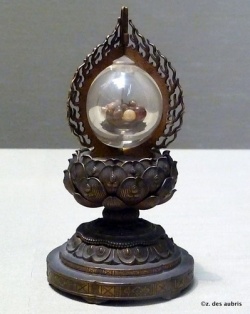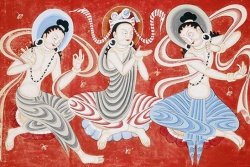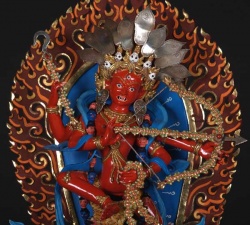The Cintamani Stone
The Cintamani Stone (or Chintamani Stone) is a legendary artifact of Buddhist and Hindu mythology, a “wish-fulfilling gem of extraordinary power.
According to Buddhist legend, it fell from the stars and landed in Tibet, where the ancient Buddhists revered it as a spiritual jewel. However, its power was considered so great, and so potentially disastrous, they ultimately sent it to the mystical, hidden city of Shambhala.
But the legend of the Cintamani Stone doesn’t end there. Esoteric theorists and modern day treasure hunters have uncovered profound possibilities. Did the Cintamani stone actually exist? And, if so, where is it now?
To uncover these mysteries, we must first travel to a distant world. For the “true” story of the Cintamani Stone begins in the binary star system of Sirius.
A Gift From The Stars
The Cintamani Stone
The Cintamani Stone (or Chintamani Stone) is a legendary artifact of Buddhist and Hindu mythology, a “wish-fulfilling” gem of extraordinary power.
According to Buddhist legend, it fell from the stars and landed in Tibet, where the ancient Buddhists revered it as a spiritual jewel. However, its power was considered so great, and so potentially disastrous, they ultimately sent it to the mystical, hidden city of Shambhala.
But the legend of the Cintamani Stone doesn’t end there. Esoteric theorists and modern day treasure hunters have uncovered profound possibilities. Did the Cintamani stone actually exist? And, if so, where is it now?
To uncover these mysteries, we must first travel to a distant world. For the “true” story of the Cintamani Stone begins in the binary star system of Sirius.
A Gift From The Stars
Sirius
What we commonly see as one very bright star in our night sky (in fact, it’s the brightest) is actually two. Sirius is a binary star system, meaning it consists of two unique stars.
Friedrich Bessel figured this out in 1844, but it wasn’t until 1862 that the second star was actually observed.
What’s interesting is that the Dogon people of Mali, Africa reportedly knew of this second star long before modern astronomers. But how?
Knowledge of the second star, called Sirius B, could not have been gained without the use of sophisticated telescopes. Skeptics claim this is nothing more than a case of “cultural contamination,” but ancient astronaut theorists view this as proof of extraterrestrial interaction with Earth’s ancient civilizations.
In fact, esoteric belief states that extraterrestrials from Sirius, perhaps ambassadors of the system, brought the Cintamani Stone to Earth seeking to establish their own unified order on our planet.
Regardless of whether or not this is true, Sirius has long played a role in human culture. The Egyptians based their calendar on it. The Greeks incorporated it in their superstitions, believing that its appearance foretold a kind of “star sickness.” In Freemasonry, it’s known as the Blazing Star, and is used as a symbol in many masonic images.
It’s entirely possible that the Cintamani Stone originated in space.
In fact, it’s very likely.
The Treasure of the World
The word “Cintamani” itself can be translated to “thought-gem” or “wishing stone.”
Its physical properties are mostly ordinary, described as green, and trapezohedron in shape. But its greater powers lie in a higher dimension, invisible to our own senses.
What looks like an ordinary rock is actually a powerful, pan-dimensional artifact.
Possession of the stone elevates its holder to a higher state of being, granting knowledge of all time and space and, consequently, the potential for world domination. And, much like the Philosopher’s Stone and the Holy Grail, its wielder may even attain immortality.
In fact, it’s theorized that the Philosopher’s Stone, the Holy Grail, and the Cintamani Stone are one and the same.
Upon its arrival to Earth, the Cintamani Stone was hidden away in the etheric plane, within the ancient city of Shambhala, and kept by the “King of the World.” However, fragments of the stone allegedly made it back into our world, and have been the focus of empires and secret societies for hundreds of years.
Many of the greatest empires of the world are said to have possessed these fragments. This implies that the stone was directly responsible for their success.
Whoever controls the stone controls the world.
Does The Cintamani Stone Really Exist?
Of course, that’s just legend. But it’s entirely possible that such a stone as described above could exist, regardless of whether or not it possesses any kind of mystical powers.
For example, the Cintamani Stone is described as a gem or a jewel, green in color, that fell from the stars. This perfectly fits the description of moldavite, a tektite formed after meteorite impacts. A meteorite impact could have, in ancient times, been viewed as a mystical event. Moldavite taken from the crater may have been revered as a heavenly artifact.
As for the location of the Cintamani Stone, an episode of Syfy’s Legend Quest examined the possibility that it may be located in the Philippines.
Say what you will about these reality shows, but you know what? They may have been right. The Kintamani mountain range in Bali, Indonesia, just south of the Philippines, was named after the Cintamani Stone. That’s a fair distance from Tibet, and the tropical environments of Indonesia match the paradisiacal descriptions of Shambhala.
Unfortunately, we may never know the true nature of this “stone of heaven,” but it is only one piece of a far greater legend.






